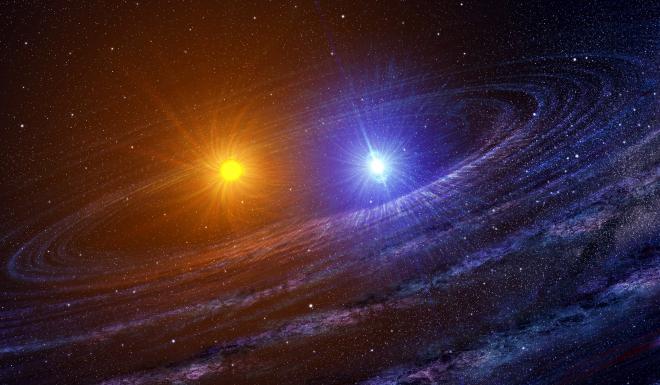The evolution of single and binary stars
Stars make up most visible matter in the Universe. The light they shine is the result of nuclear fusion reactions occurring within their interior converting the simplest element, hydrogen, to helium and beyond, in the most massive stars all the way to the most stable element, iron.
The Binary Population and Spectral Synthesis (BPASS) team, led by the University of Auckland’s Dr JJ Eldridge and the University of Warwick's Dr Elizabeth Stanway, have been using NeSI’s Pan cluster to model the evolution of stars, including that of seldom studied binary stars.
The evolution of a single star like our Sun is relatively well understood. The physics required to model a star is broken down into linked difference equations and tables for reaction rates, opacity and equation of state. These problems were initially solved by human “computers”, however in the 1960s the first electronic computers procured by Universities were turned to the problem of stellar evolution and the very first computations of a star’s evolution would take weeks to complete. Today on NeSI’s Pan cluster, a highly detailed model can define a star's entire evolution in about five minutes.
This rapid advancement in both speed and accuracy has meant that greater numbers of stars can be quickly computed to see how different factors affect their evolution. The two primary factors are their initial mass and initial composition. To fully understand the diversity possible in stellar evolution requires perhaps a few hundred models, something which can now be computed with the Pan cluster in an hour, rather than the days it would have taken just over a decade ago.
There is one problem however, which is that most stars are not single. Only a quarter of stars are thought to be born as single stars, while half have a companion star and are in a binary system. The remaining quarter are in higher order multiples. The evolution of a binary star is different as the stars can get in each other’s way and exchange mass and angular momentum, dramatically altering their evolutionary outcome.
Until now the evolution of binary stellar systems has only been studied by a few groups, as this issue vastly increases the initial parameter space for the evolution of a star. This is due to the need to vary the initial masses of two stars and also the initial separation, as stars in tighter orbits are more likely to interact earlier in their lives than a wider binary. So, rather than requiring a few hundred models, something approaching a few hundreds of thousands of models are necessary. This would take approximately a year on a single desktop computer, but with NeSI’s platforms it might take only a week to run the models, even after having to rerun different models because of any numerical problems.
Using NeSI’s Pan cluster, the BPASS group have been able to create a detailed set of stellar models that include binary interactions. While the first version of the BPASS included only 15,000 stellar models, use of the cluster enabled the researchers to increase the resolution of their initial parameter grid by a factor of ten to nearly 200,000 models. This in turn increases the accuracy of the predicted stellar populations, which are now state of the art and have been made freely available on the web for astrophysicists to use.
The next important question facing the researchers is what can they then do with all of these models? Not only is it possible to study individual stars, now the models can also be combined to predict what a stellar population would look like at different ages. More massive stars live their lives faster than less massive stars, so the luminosity and spectrum of a population varies with age. This is what makes it possible to work out the masses and ages of galaxies and then understand how, as we look further back in time, galaxies have evolved over the age of the Universe. With the large amount of stellar models to combine, it would only be possible to perform such a population synthesis quickly on a high performance system like NeSI’s Pan cluster.
The results of this project are also being used by Dr Eldridge’s three PhD students for a range of related projects. Liam McClelland is using BPASS to study the most massive stars that have such strong stellar winds, they lose all hydrogen from their surface and become rare helium stars. Lin Xiao is studying the youngest stellar populations, modelling the emission nebulae to estimate how many stars are being formed, then comparing this to the observed supernova rate to check if the synthetic populations are correctly predicting the number of stars being born and dying. John Bray is studying the motion of stellar remnants, neutron stars and black holes, which are given kicks during their progenitor stars’ supernovae. He has shown that we can only explain the observed distribution of space velocities of neutron stars if most supernovae occur in binaries.
Dr Eldridge says, “Our future plans for BPASS heavily involve use of NeSI’s platforms to refine our understanding of stellar populations. One key task will be to create more different stellar model sets where we have varied the uncertain physics in our binary models to understand how our predictions depend on these uncertainties.”







